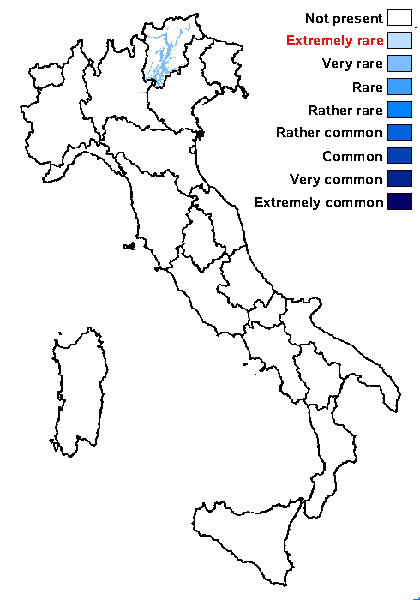Verrucaria strasseri Servít
Stud. Bot. Čech., 9: 107, 1948
Synonyms:
Distribution: N - TAA (Servít 1948).
Description: Thallus crustose, endosubstratic, whitish-grey, not delimited by a black line. Perithecia black, 0.15-0.38 mm, fully or ¾-immersed in the rock, leaving deep pits in the rock when they fall off. Involucrellum apical, c. 50-90 µm thick, adpressed to exciple; exciple globose, c. 0.22-0.26 mm across, the wall pale to dark brown; hamathecium of branched periphyses and periphysoids measuring 30-50 x 1.5-2.5 µm, interascal filaments absent; hymenial gel hemiamyloid, I+ red (I+ blue at very low concentrations of I), K/I+ blue. Asci 8-spored, subcylindrical to oblong-clavate, I-, fissitunicate, the wall thickened above, c. 88-95 x 26-28 µm, Verrucaria-type. Ascospores 1-celled, hyaline, ellipsoid, (23.6-)24-28(-30.2) x (10-)10.4-12.5(-13.7) µm. Photobiont chlorococcoid. Spot tests: K-, C-, KC-, P-, UV-. Chemistry: without lichen substances. Note: a poorly known calcicolous species described from the surroundings of Roveredo (TN); according to Pykälä & al. (2020) the species may differ from the V. devergens- and V. subtilis-complexes by mostly fully immersed perithecia, and from the V. subtilis-complex by slightly larger perithecia and a thicker involucrellum.
Growth form: Crustose endolithic
Substrata: rocks
Photobiont: green algae other than Trentepohlia
Reproductive strategy: mainly sexual
Commonnes-rarity: (info)
Alpine belt: absent
Subalpine belt: absent
Oromediterranean belt: absent
Montane belt: absent
Submediterranean belt: very rare
Padanian area: absent
Humid submediterranean belt: absent
Humid mediterranean belt: absent
Dry mediterranean belt: absent

Predictive model
Growth form: Crustose endolithic
Substrata: rocks
Photobiont: green algae other than Trentepohlia
Reproductive strategy: mainly sexual
Commonnes-rarity: (info)
Alpine belt: absent
Subalpine belt: absent
Oromediterranean belt: absent
Montane belt: absent
Submediterranean belt: very rare
Padanian area: absent
Humid submediterranean belt: absent
Humid mediterranean belt: absent
Dry mediterranean belt: absent

Predictive model
 Index Fungorum
Index Fungorum
 GBIF
GBIF

